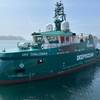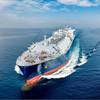New Technology Debuts in Oslo
Wärtsilä Corp., the ubiquitous propulsion system manufacturer announced that it had received a contact to supply the complete marine power system for the first of a series of environmentally safe 40,000-dwt chemical/product tankers building at the San Marco shipyard in Italy. In an interview with Wärtsilä's Mikael Mäkinen earlier this year, he stressed that the company was expanding beyond the mere business of manufacturing engines, seeking to become a single source propulsion system provider, or, as the company touts, "The Ship Power Supplier."
For the 40,000-dwt tankers, Wärtsilä will be just that, as it is responsible for the complete functionality of the system. In addition to supplying the hardware, it will provide the shipyard with all of the functional drawings and will be supervising the plant's installation, commissioning and sea trials. The ship will be equipped with a Wärtsilä 6L64 medium-speed diesel engine, of 12,060 kW output at 333 rpm and a CP 6,200 mm diameter Lips propeller, together with shafting and reduction gear. The new vessel will measure 563 ft. (171.6 m) long and feature 12 cargo, two slop and one recovery tank. The propulsion package will give the ship a maximum 17-knot speed on a 34 ft. (10.3 m) draft, and a service speed of 16 knots.
Leica made waves on the electronics front by introducing first fully integrated GPS/DGPS/AIS shipboard system. While the final standards regarding AIS are still years in the making, Leica — traditionally a company that pushes the innovation edge — has delivered a product in the MX 420, which incorporates a high-accuracy MX 421 GPS/DGPS receiver and an IMO-compliant AIS transponder system, with a combined control and display unit. Optionally, the MX 420 AIS can be interfaced with an already installed GPS or DGPS receiver onboard instead of the MX 421. The AIS transponder module in the MX 420 system was designed and developed by SAAB TransponderTech, and meets all specifications for marine AIS shipboard equipment, and is designed to be compliant with future standards through software upgrades. The combined system takes advantage of another Leica innovation, the MX 421, a type-approved high-precision GPS/DGPS "smart antenna." It was the first GPS product to use the new Silicon Germanium (SiGe) receiver chip, and was developed jointly by Leica and IBM.
In the wake of corporate consolidations, marine buyers can sometimes be confused as from which house comes which product. ExxonMobil, which completed the granddaddy of all mergers last year in combining the two oil industry behemoths, announced a plan to simplify the marine lubricants buying choice to its deep sea customers. ExxonMobil Marine Lubricants announced that its Mobilgard brand will be the flagship product line offered to deep sea customers. The Mobilgard brand includes a full range of mineral oils and synthetic lubricants for marine engines and equipment. The company will retain the Esso and Exxon brand of marine lubricants for the coastal and inland sectors. The company also introduced an enhanced oil analysis program with new Web-based delivery capabilities. Dubbed Signum Oil Analysis, it will replace the company's Exxcare and Progressive Fast Analysis (PFA) oil analysis programs. "The upgraded Exxcare and PFA programs and adds new on-line capabilities that will make it easier for customers to access information and remedy problems," said Wayne Sirois, global marketing manager, ExxonMobil Marine Lubricants. The new system allows customers to gain access to their specific accounting information, including on-line lube charts, through the Internet, without adding new software.
Transas Marine, another company synonymous with advanced marine technology, in June launched the first of its new generation Navi-Sailor navigation systems, Navi-Sailor 3000. The system incorporates all the functionality of the previously type-approved ECDIS with an additional array of innovative features. According to Peter Mantel, director of marketing and business development, Transas made the decision about a year and a half ago to invest in a new platform that would satisfy the technological needs of today and tomorrow. The system has been designed with flexibility in mind, as it features: the option of North-Up/Course-Up/Head-Up chart display modes; integrated weather forecasting, multiple chart display and user-selectable screen layout; advanced Route Planning, Radar Overlay and Playback facilities; Relative and True Motion display; and an advanced (U)AIS transponder interface, that will be modified with the final specification come out. The company intends to launch two additional products in the series later this year.
Hamworthy KSE AB, the Swedish-based dry cargo handling division of Hamworthy KSE, stressed that it was involved in far more than the simple design, manufacture and supply of cargo handling solutions. The organization is involved with three major European shipping transport projects, including the Improved Port Ship Interface (IPSI) project, which aims to reduce cargo transported on Europe's clogged motorways with an integrated solution highlighting short sea shipping and inland waterways transportation.
Other significant developments that occurred throughout the week included:
MacGregor announced that its new Sherlog ultrasonic testing system — designed to quickly and easily check the cargo access sealing system — has been type approved.
Lloyd's Register completed a study to find the optimum solution to the question of how to most efficiently propel the next generation of Ultra Large Containerships (UCLS).
Finland's Loipart introduced a combined fire resistant and thermally insulated door for cold rooms and freezers, the A-60 line.
Brunvoll Bucks The Trend,And Prospers
At a time when many companies in the marine industry see mergers as the key to success, Brunvoll AS, continues to steer its own course. In fact, as Knut Andresen, Brunvoll's technical director said recently, acquiring a "package" of systems from a large concern may not be the best solution for shipowners anyway, because of the temptation for some companies to hide costs within the package.
Brunvoll has been designing and manufacturing thrusters for more than 37 years since it first introduced tunnel thrusters onto the Norwegian market. It continues to specialize in thrusters to this day, and has gained a worldwide reputation in that sector of the market, choosing to design and manufacture thrusters that are customized to meet the demands of individual ships, rather than low cost, off-the-shelf equipment that is poorly suited to individual shipowners' requirements.
In the cruise ship sector, one of the main reasons for increased demand for thruster capacity is the growing requirement for better position keeping capability. Often this is because anchoring restrictions prevent the use of traditional means of maintaining a ship in position, leading to increased use of azimuthing propulsion units and larger bowthrusters.
In other sectors of the shipping industry, such as offshore supply vessels and cable layers, additional thruster capacity greatly enhances position keeping, providing a redundant propulsion capability, and reducing operating costs.
The most important factor in selecting the proper thrusters, said Andresen, is that the thruster or thrusters are matched to its operating requirement. Some ships may use their thrusters routinely, almost on a daily basis; but on board other types of vessel, although the thrusters may be rarely used, they need to be designed to a very high, demanding specification which can't be met with low cost, off- the-shelf products.
Brunvoll has also gained an enviable reputation for its retractable thrusters, which continue to be especially popular in the offshore market, particularly on shuttle tankers, cable layers and multi-purpose offshore support vessels.
In keeping with the company's emphasis on innovation and on meeting specific customer requirements, Brunvoll has also developed retractable thrusters designed both for use when lowered and when retracted.
A typical application is on board a shuttle tanker, where rolling motions can cause a conventional tunnel thruster to draw air if they break the surface in bad weather, preventing them from maneuvering precisely enough to load safely at sea. This problem is overcome, however, when a retractable thruster is lowered beneath the ship.
Unitor Unveils Range Of Welding Machines
In response to changing market requirements, Unitor has enhanced and expanded its range of shipboard welding machines for onboard repair and maintenance use, with two new inverters and three upgraded units.
Unitor can now provide vessel operators and ship's crews with hardware that meets every onboard welding requirement, from the simplest weld to the most complicated and demanding steel repair job.
The new range of welding machines from Unitor comprises:
• UWI 140 — an upgraded machine ideal for daily onboard maintenance work
• UWI 200 — a new, compact, portable welding inverter for cost-conscious users
• UWI 400 — an upgraded powerful, high capacity, portable welding inverter
• UWR 303 — a new welding rectifier offering ship's crews an alternative to welding inverter technology
• UPC 838 — an upgraded powerful, portable plasma cutter.











